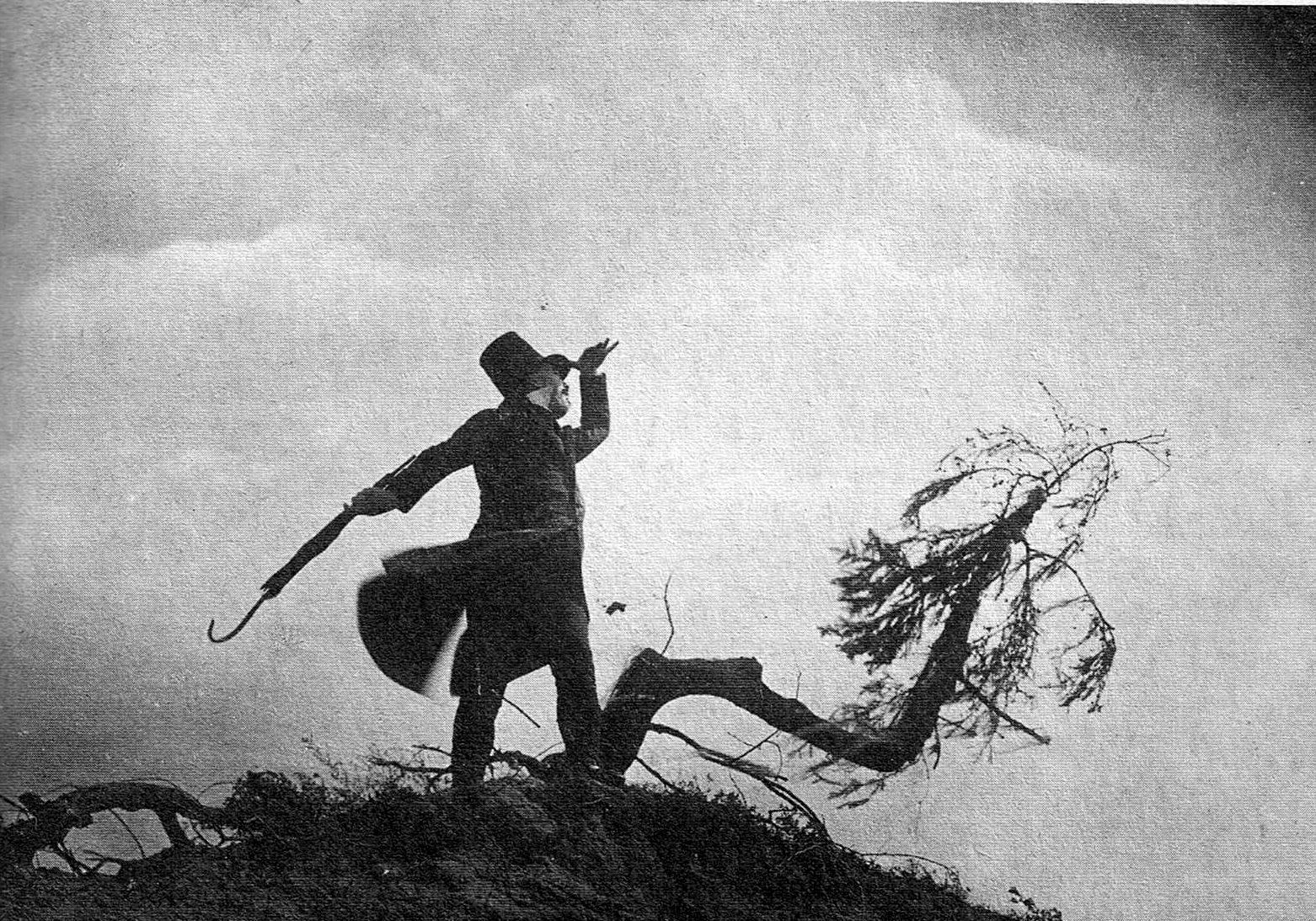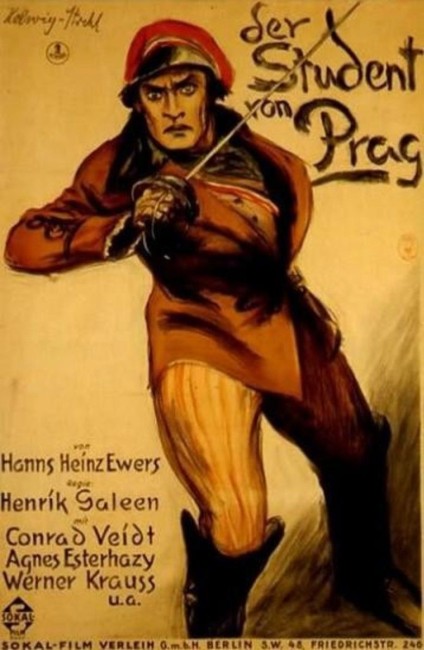(Der Student von Prague)
Crew
Director – Henrik Galeen, Screenplay – Hanns Heinz Ewers & Henrik Galeen, Based on the Novel by Hanns Heinz Ewers, Producer – H.R. Sokal, Photography (b&w) – Guenther Krampf & Erich Nitzshmann, Art Direction – Herman Warm. Production Company – Sokal-Film GmbH.
Cast
Conrad Veidt (Balduin), Werner Krauss (Scapinelli), Agnes Esterhazy (Countess Margit Schwartzenberg), Elizza La Porta (Liduschka), Ferdinand Von Alten (Count Waldis), Fritz Alberti (Count Schwartzenberg)
Plot
Balduin, a university student in Prague, bemoans his poverty. He then receives a visit from the mysterious Scapinelli who asks Balduin what his wish would be. Balduin says that he wishes a wealthy woman would fall for him. And so Scapinelli conjures on a hillside and causes the horse that Countess Margit Schwartzenberg is riding in the middle of a fox hunt to throw her near where Balduin stands. Balduin is captivated by the countess. Scapinelli later appears to Balduin with a contract that offers 300,000 florins in return for one thing in his room. Balduin eagerly signs – only for the thing that Scapinelli’s chooses to be Balduin’s reflection in the mirror. Now wealthy, Balduin pursues his interest in Countess Margit. A letter from him falls into the hands of Margit’s fiance Count Waldis and Balduin issues a challenge to a duel. However, the reflection steps in and callously kills Waldis. The doppelganger now causes mischief and ribaldry in Balduin’s name, ruining his reputation and having him thrown out of the university.
The Student of Prague is a story that has been filmed a number of times. It comes from Hanns Heinz Ewers, an author that wrote a number of fantastic works around this era, most notably the multiply-filmed novel Alraune (1911). Ewers was a popular German author in the day, although fell into discredit during later years after becoming an early supporter of the Nazis. Ewers wrote the script for the original version of the film The Student of Prague (1913), which was made as a vehicle for actor Paul Wegener, a German star of the era, who also co-directed.
Following the 1913, there came the classic German Expressionist cycle following the success of The Cabinet of Dr Caligari (1919). (See German Expressionism for a more detailed overview). In the midst of this, The Student of Prague was remade here – indeed, the influence of The Cabinet of Dr Caligari makes itself felt in the casting of Werner Krauss, who played the sinister title doctor in that film and is cast as The Devil figure of Scapinelli here, while Conrad Veidt who played Cesare the Somnambulist is cast as Balduin.
The director of The Student of Prague was Henrik Galeen. Galeen directed a number of other films in the German silent era, including co-directing the first, now lost version of The Golem (1914) with Paul Wegener, as well as the second adaptation of Hanns Heinz Ewers’ Alraune (1928). Galeen also wrote the scripts for a number of other key genre works from this period, including The Golem (1920), Nosferatu (1922) and Waxworks (1924). He was also portrayed by Robert Aden Gillett in Shadow of the Vampire (2000).

The Student of Prague comes with the great visual flair that directors of the German Expressionist era like Fritz Lang and F.W. Murnau mastered. There is a fabulous scene where Werner Krauss’s Scapinelli stands silhouetted on the line of a hill beside a tree that is twisted and bent out of shape, seemingly a symbol of wrongness, while choreographing the hunt taking place on the plain below him as though he were a conductor. There are some neat visual tricks like where Werner Krauss encourages Conrad Veidt’s reflection to step out of the mirror. Or where Conrad Veidt romances Agnes Esterhazy on a balcony and Werner Krauss’s giant shadow stretches up to touch them from the garden below. The film climaxes on some magnificent scenes with Conrad Veidt pursuing the doppelganger through the streets and colonnades of trees, accompanied by moody lighting and a blowing wind.
The Student of Prague came out the same year as F.W. Murnau’s classic Faust (1926) and both have very similar themes about an innocent scholar being tricked out of his soul by a jovial Devil. Up against Murnau’s masterful work, The Student of Prague is somewhat the lesser. The story here is essentially a borrowing from Edgar Allan Poe’s story William Wilson (1839) in which a man is thwarted at every step by his doppelganger – although in the Poe story it is the hero who is evil and the doppelganger good, whereas here it is the other way around and with the addition of a pact with the Devil plot. On the minus side, up against some of the other classics of this era, The Student of Prague seems somewhat slow and melodramatic. Far more time is spent on the romantic elements than the more interesting scenes of the doppelganger going amok.
The story has been remade as The Student of Prague (1935), a German sound-era production, and The Student of Prague (1990), a Czech-made tv mini-series.
Trailer here
Full film available here


